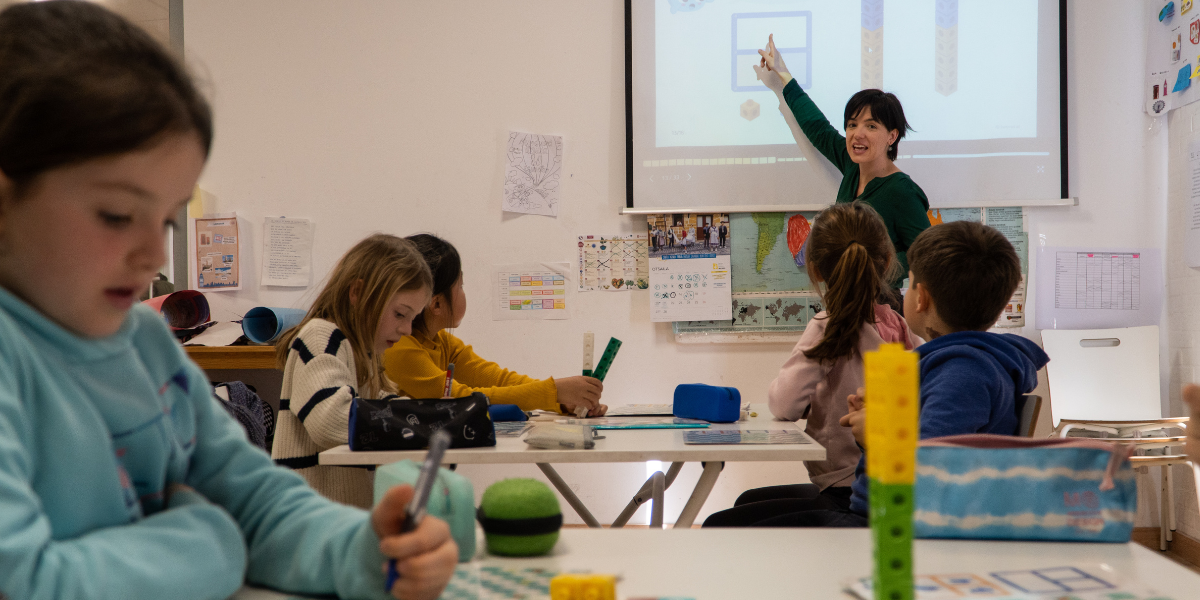In a traditional class, the challenge of addressing a range of abilities and learning styles was camouflaged by the teachers’ strategies: if all we do is explain and write on the blackboard for the entire session, it is irrelevant whether the audience is a single student or one hundred and fifty.
Today, however, in classrooms where the driving force for learning is the process of discovery and where students spend more time manipulating materials and talking with each other than listening to lectures, variety emerges in all its splendor and complexity. If we add the fact that educational research has trained our eyes and increased our sensitivity, we can no longer look the other way. We must strive to cater to all learners in the classroom, induce personalized learning experiences, ensure that each student can progress at his or her own pace, etc.
Great! With all the nuances that may be required, the vast majority of teachers will agree with these premises.
The problems of personalizing learning
It all sounds great, on paper. Put into practice, the student-to-teacher ratios make it almost impossible to personalize learning, for everyone, at all times: if you cater to one child (or group), you do not cater to the others. The first solution, then, seems simple: reduce the student-to-teacher ratios. Either we make classes smaller, or we have an extra teacher per classroom. In most cases, however, schools do not have the resources to cope with this reduction.
As if that were not enough, we also lack specialized training. What do we mean by differentiated instruction? What is the meaning of the acronym UDL, which often appears in this context? What learning difficulties can we encounter in the classroom? How can we help students who have them? What about high-capacity learners? Moreover: what do we understand by high capacities? Is it better to mix students or to make homogeneous groups?
In our experience, we know that many schools have initiated processes to get trained and to answer these questions. Others will do so soon. In this article on differentiated instruction, we will try to begin to provide some enlightenment regarding these questions and explain how we are addressing them. Let’s go!
Addressing differentiated learners in the classroom from the Universal Design for Learning (UDL) approach
The first thing to clarify is that at Innovamat we do not do magic. We are not a method, we do not have a magic formula to get all students to learn the same thing at the same time. This does not exist. But it does not mean that nothing can be done either.
The UDL follows guidelines that began as a project by the U.S. Department of Education’s National Center on Accessing the General Curriculum (NCAC), with Anne Meyer and David Rose in charge, Harvard University (2002, 2005, 2006). D., Harvard University (2002, 2005, 2006). Basically, these guidelines focus on environmental barriers rather than deficits:
- Cognitive
- Physical
- Sensorial
- Emotional
- Curricular
- Communicative
- Structural
These are the barriers, which do not affect everyone equally, that prevent all children from learning the same thing. For this reason, the UDL presents three main guidelines from which we design the sessions to minimize the effect of these barriers:

Own elaboration based on Dalmau et al. (2015)
In Innovamat’s proposal, we try to ensure that all activities motivate the students from the very beginning. At times, we achieve this through narrative videos (the Cricks in Kindergarten, the Bmaths in Elementary School, and Sam’s Journey in Secondary Education), which contextualize some sessions. At other times it is the open-ended questions, which have a variety of both strategies and solutions, and provide a stimulating challenge.
We have focused on the process of Communication and Representation since our conception. This process is present in all the sessions and the competency-based assessment we propose. The use of a wide variety of resources, from projectables, applets from the digital platform, and interactive videos, to logbooks or notebooks, and manipulative material specific to each course, also contributes to the fact that students approach concepts from different perspectives to consolidate connections.
Action and expression are also present in the proposal. The very use of manipulative materials and resources facilitates experimentation, sometimes freer and sometimes more guided.
Well-chosen activities: low floor and high ceiling
When the didactic team thinks about the proposal’s activities, we always keep the metaphor of “low floor and high ceiling” in mind. This is a recurring idea in research by Jo Boaler, from Stanford University, and the NRICH project, at the University of Cambridge (2013, 2017). Boaler herself (2022) talks about it this way in one of her latest works:
“It’s very hard to find tasks that are perfect for all students, but when we open up tasks and make them broader, when we make them into what I call low floor, high ceiling, this becomes possible for all students.“
When the activity is “low-floor“, it means that it invites all students to come in and start thinking, based on a simple premise. If, in addition, the activity is “high ceiling“, those who can, will take off to go further. A good example of this are the activities that follow the “Which one does not belong?” (WODB) process.
Any student can start thinking and discover simple arguments, such as “the one that doesn’t belong is D because it is the only shape without blue pieces”. But within the same approach, another child may argue that “the one that doesn’t belong is B because it is the only one without axes of symmetry” and go further by studying the symmetry of each shape.
The key to inclusion is to avoid fragmenting the class, i.e., to avoid having a large number of students doing “what they had to do today” and having those who show difficulties or high abilities doing other activities. This way, we encourage the whole group to be part of the conversation and get involved in the same task.
This allows all students to have the opportunity to experience a moment of mathematical glory in the classroom, where they are the stars in a reflection or a discovery. These moments are fundamental to build a positive image of math and reduce the mathematical anxiety that it sometimes causes.
Later, when they practice what has been built in group work on their own, either in the logbook, in the notebook, or in the digital practice platform, is when we can better identify the different learning paces and act accordingly, with support or extension materials and activities. Only the teacher has the information required to apply this attention in a personalized way, depending on the needs of each student.
Learning difficulties identified in the mathematics classroom
There are three common learning difficulties that have a significant effect on children when they are in the mathematics classroom: dyscalculia, dyslexia and dysgraphia. In addition, other disorders, such as ADHD, also pose a barrier for many students, without going into more specific disability or neurodiversity issues that may require an individualized plan (IP).
These difficulties may be dealt with in a number of ways, but one of the most widespread is response to intervention (RTI). RTI is a model that detects difficulties based on how children respond to a specific adaptation or intervention and is already being implemented across the board in schools in countries such as the United States, the Netherlands, and Finland.
In a future article in this blog, we will address learning difficulties and the RTI model in more depth. We will do this with the help of Innovamat’s research team, which was formed this year and has already begun several studies on math anxiety and learning difficulties and has also developed an RTI for children who need it most to improve basic skills.
Dalmau, M., Sala, I., Llinares, M. (2015). Pautes sobre el Disseny Universal per a l’Aprenentatge (DUA). Facultat de Psicologia, Ciències de l’Educació i l’Esport Blanquerna,
Universitat Ramon Llull. Barcelona.
Boaler, J. (2022). Mathematical mindsets: Unleashing students’ potential through creative mathematics, inspiring messages and innovative teaching. John Wiley & Sons.
NRICH team (2013). Low Threshold High Ceiling – an Introduction. NRICH – Millennium Mathematics Project. Cambridge University. Disponible a: https://nrich.maths.org/10345
NRICH team (2017). Creating a Low Threshold, High Ceiling Classroom. NRICH – Millennium Mathematics Project. Cambridge University. Disponible a: https://nrich.maths.org/7701
Rose, D., Meyer, A., Hitchcock, C. (2005). The Universally Designed Classroom. Eds. Harvard Education Press. USA.
Rose, D., Meyer, A. (2006). A Practical Reader in Universal Design for Learning. Eds. Harvard Education Press. USA.






